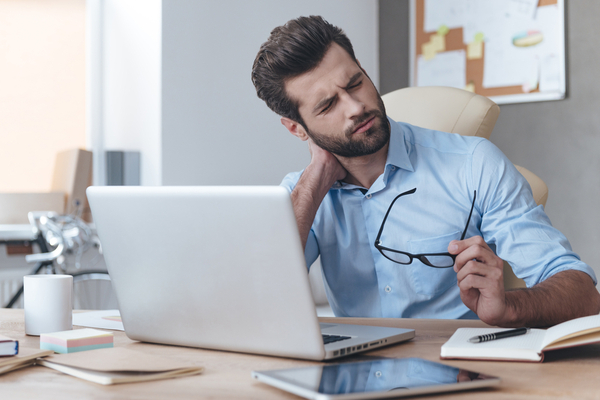
I’m not talking about a significant other or your child being a pain in the neck. I’m talking about physically having pain in your neck. Do you wake up in the morning, or go through the day with headaches neck pain or shoulder stiffness that possibly gets worse? Chances are you can be suffering from chronic head or neck pain. You ask how/why does this happen? What can I do to get this pain? This article will talk about common causes that cause head and neck pain.
Commonly, people who are “desk jockies (those who have desk jobs) or couch potatoes can experience such pain. For eight hours a day, seven days a week you’re sitting at your desk wondering if it’s time to punch out for the day. In the mean time, you try to pass the time playing solitaire or binge watching YouTube “Fail” videos. Ok maybe for some of you this may be the case. Or if you’re a couch potato, watching hours of TV per day, this can affect your potato like posture as well. Regardless of your daily duties or lack there of, sitting for long periods of time looking at a computer or tv screen or sitting through meetings all day can wear on your back, neck, head…pretty much your whole body.
In my experience as a therapist, many people do not know the proper posture needed while sitting for prolonged periods of time. Over time, people who have poor posture will demonstrate some common positions. Most of us slouch when we sit and this causes a few things: The shoulders become increasingly pulled forward into a more rounded posture. To make up for the forward posture in your shoulders, you have to lift your head more to look up at the screen, causing stress to the muscles in the back of your neck. Sound pretty painful?
This leads me to my next point. Over time, the muscles that connect to your shoulders, neck and back can be victims of what’s known as muscle imbalance. Muscle imbalance is caused when the normal resting tension between opposing muscle groups in the body become abnormal, meaning when one side of the body get’s tight the opposite of the body gets stretched. This can cause dysfunctions in how you move your head (rotating, looking up, looking down, etc). Not only can these muscle imbalances affect how your head move but also they can lead to an increase in headaches and neck pain. If not treated properly, serious injury can eventually take place to your neck.
Ok, we covered what can happen to your muscles in your neck. Now let’s talk about the bones in your neck called vertebrae. Over time, the abnormal stresses caused by your posture and muscle imbalances can cause the vertebrae in your neck to eventually become positioned in a way that can wear out the joints in your vertebrae, leading to a few different symptoms.
One of the main symptoms that can occur is arthritis. Arthritis is inflammation in the joint between two bones. Each vertebrae in your neck moves on top or below one another (think about toy building blocks stacked on one another) and relies on cartilage in between each joint to glide easily. Cartilage is a rubbery tissue that acts as a cushion between joints. If there is a muscle imbalance, movement of each joint can put abnormal stress on the cartilage between the joints, and over time the cartilage can get damaged enough to cause joint pain and stiffness.
Another symptom that can derive from poor posture is cervical spine stenosis. Cervical spine stenosis is a slow, progressive condition that pinches the spinal cord in the neck. Symptoms can be of course neck pain, and tingling and numbness from the neck to as far down as the hands (depends on the severity of the stenosis). Side note: stenosis can affect the mid back and low back vertebrae. If this is the case, talk to your doctor about seeking physical therapy.
Additionally one other symptom that poor posture can lead to is a disc herniation or a “bulging disc”. Discs lay in between your vertebrae next to the spinal cord and act as shock absorbers (as your walking, jumping, sitting, standing, etc.) As the vertebrae degenerates, either from age or posture sometimes, the innards of the discs can get compressed to the point where some of its material can “leak” out the side and can compress or “pinch” the nerves in your spinal cord. If this happens, symptoms can lead to sharp shooting pain down the arms in addition to tingling and numbness that can go into your hands. If this is the case, like I said previously, see your doctor.
So what to do, what to do? When you see your doctor, they will refer you to physical therapy regardless if you require or do not require surgery. Physical therapy will help you on your road to reducing your neck pain because physical therapists spend A LOT of time researching and applying the best techniques to reduce your pain in the least aggressive manner possible. They will evaluate you and determine the best course of action depending on your symptoms and treat you in the most optimal time possible. PT’s will teach you exercises to strengthen and stretch muscles that need them. They will also teach you proper posture while sitting and standing to reduce the amount of stress on your body. Notice I do not say, “PT’s will GIVE you exercises or GIVE you proper posture.” I say they “will TEACH you” these so you can learn and apply these gold nuggets of information at home with your home exercise program. Don’t let pain be a pain in the neck. If you’re suffering from neck or head pain, address this issue quickly because like I’ve stated earlier, not addressing this pain can lead to some unwanted long term injuries.


